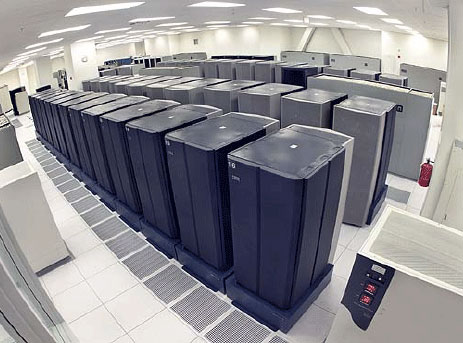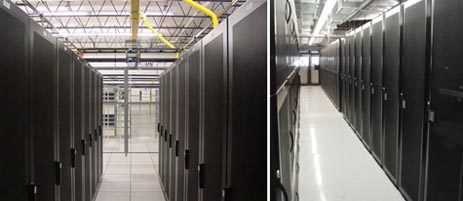 One server alone, we read, has the "same carbon footprint as your average SUV doing 15 miles to the gallon. Yet, whereas the SUV is seen as a villain from the environmental perspective, the server is not."
One server alone, we read, has the "same carbon footprint as your average SUV doing 15 miles to the gallon. Yet, whereas the SUV is seen as a villain from the environmental perspective, the server is not."Note, meanwhile, that I have not independently verified these numbers; I am simply repeating someone else's claims.
As Money explained last summer, these "server farms" and "data centers" can each use up to "a small city's worth of electricity" – and most of that electricity goes toward "cranking up the air conditioning to make sure the computers don't literally melt themselves into slag."
Returning to New Scientist, we read that, "with more than 1 million computers on the planet, the global IT sector is responsible for about 2% of human carbon dioxide emissions each year – a similar figure to the global airline industry."
And here I am, writing BLDGBLOG, doing my part to cut down on the world's use of internet servers...
 So what to do? Do we make our server farms hydroelectric? It's already happening. Do we make them wind-powered? Already happening. Do we go solar? That's happening, too.
So what to do? Do we make our server farms hydroelectric? It's already happening. Do we make them wind-powered? Already happening. Do we go solar? That's happening, too. As Business 2.0 wrote back in October: "Massive data centers are vital to the economy. They are also notorious power hogs. If their numbers keep growing at the expected rate, the United States alone will need nearly a dozen new power plants by 2011 just to keep the data flowing, according to the Environmental Protection Agency."
And so we read:
- That's why a small server-farm company called AISO.net (for "affordable Internet services online") has gone completely off the grid. Located 80 miles southeast of Los Angeles in the desert hamlet of Romoland, AISO.net has flanked its 2,000-square-foot building with two banks of ground-mounted solar panels, which generate 12 kilowatts of electricity. Batteries store the juice for nighttime operation.
Sure – or we could build our server farms in Iceland, where geothermal and hydroelectric power is easy enough to find.
 In any case, I can't help but wonder if the ecological effects of this archival instinct to preserve the past at any cost – whether we store something inside air conditioned warehouses full of books that no one wants, or in the well-lit galleries of potentially unnecessary new museums, or even out on server farms somewhere in the rainy hills of Oregon – are really worth it.
In any case, I can't help but wonder if the ecological effects of this archival instinct to preserve the past at any cost – whether we store something inside air conditioned warehouses full of books that no one wants, or in the well-lit galleries of potentially unnecessary new museums, or even out on server farms somewhere in the rainy hills of Oregon – are really worth it. And I can't help but suggest that they're not – even if that means I'll no longer have a place to save BLDGBLOG.
But we are making the earth unearthly, through the knock-on effects of global climate change, in order that we might hold onto the human past for another generation – reading old books, preserving films, saving emails.
 [Image: The Mare Nostrum supercomputer, Spain; this is not a server room].
[Image: The Mare Nostrum supercomputer, Spain; this is not a server room].So is the anthropological project of preserving ourselves really worth its environmental effects?
Are we saying that the planet may soon become unrecognizable, even uninhabitable, because of runaway climate change, and yet at least it'll have lots of really great archives...?
Is this the long-term historical irony of humanism – with its museums and libraries, its institutionalized nostalgia – that all these air conditioned warehouses and rural server farms don't represent the indefinite continuation of the humanist project but, rather, that project's future ecological demise?
(Read more about "green" server farms over on Worldchanging. See also the previous post).
No comments:
Post a Comment